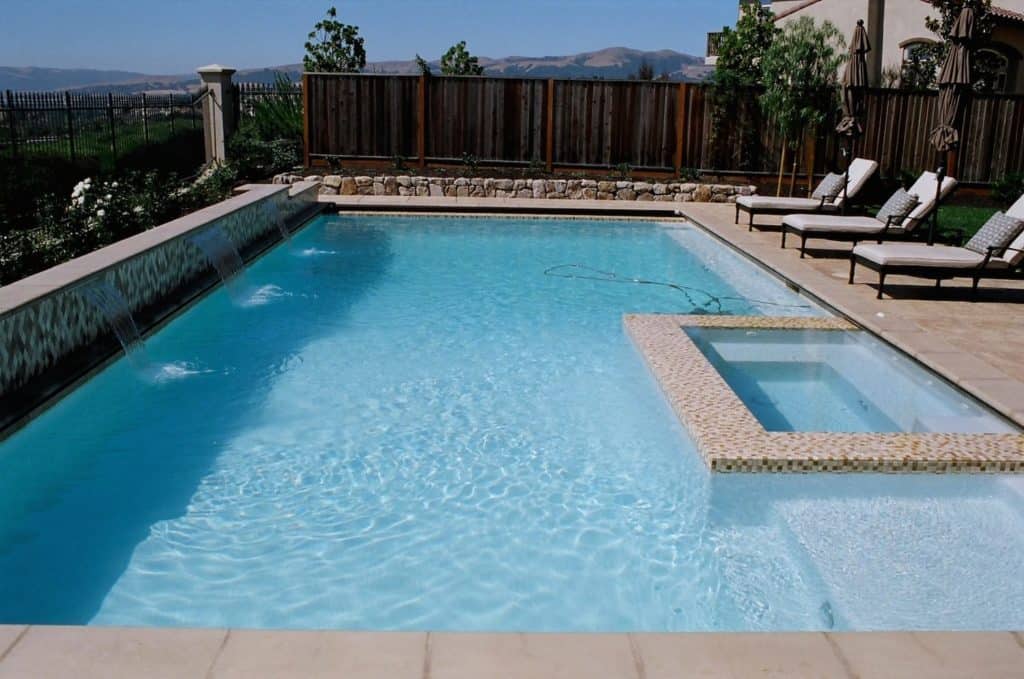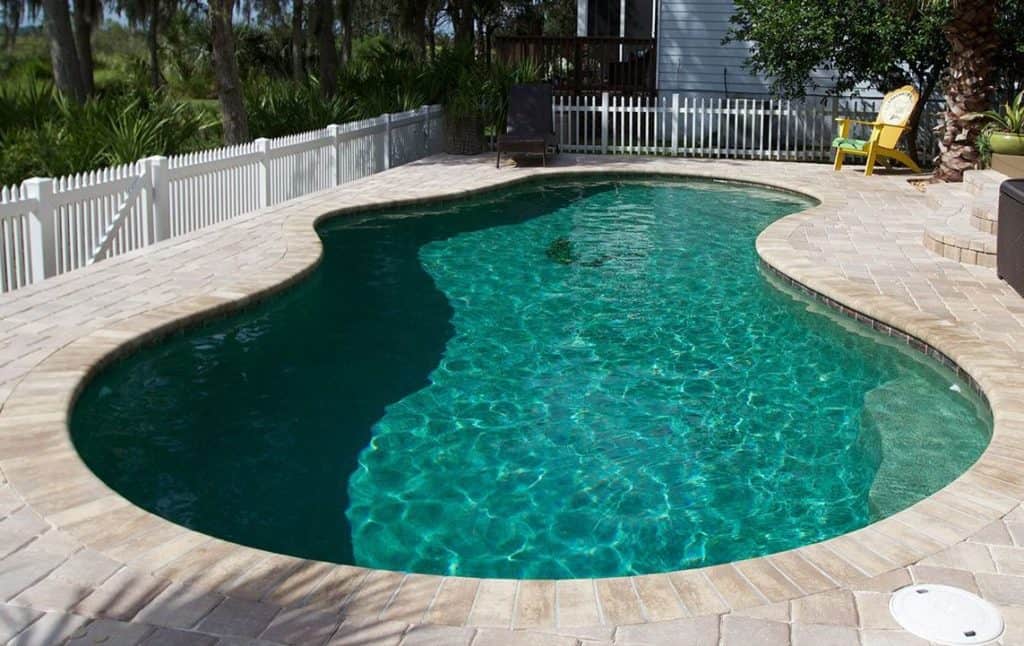For those that have decided on a plaster finish for your inground pool, you’ll need to figure out the proper pool plaster color for the look you’re going for.
Your pool water color is determined by four things: the pool plaster color, the natural environment surrounding the pool (giving off light reflections), the amount of sunlight the pool gets, and the depth of the pool.
Why Pool Plaster Color Matters
The color surface of your pool plaster can dramatically alter the look of your pool.
In its purest form, pool plaster is basically just white portland cement. By adding various dyes/colorants, you can change the plaster to any color you wish.
Why change the color?
Changing the plaster’s color changes the tint of the water. This will make all the difference if you want your pool to have a tropical feel, a lake feel, or a lagoon feel.
The most common plaster colors are: light (blue or gray), blue, green, teal/turquoise, and dark (gray/black).
Pool plaster color can also play a role in hiding imperfections. Over time, the plaster will begin to show signs of fading and deterioration due to the sun’s UV rays and harsh pool chemicals in the water.
Stains, scaling and shading of the plaster will be especially noticeable on white and similarly light colors, whereas a darker plaster can help mask this issue.
7 Pool Plaster Color Ideas
So you’re going for a certain “look” for your pool, but not sure how to get it?
Here are some real-life examples showing what a pool’s water looks like according to the appropriate plaster color.
1. Standard Plaster (White)
White plaster is a tried and true, classic finish. It was popularized in the 1960’s when it was basically the only pool finish that was available.
Today, white plaster is used for those that want to recreate that Hollywood glamour feel, and they’re still widely used (especially in Greek villas).
With white plaster, the resulting water color will be the traditional swimming pool look of light turquoise. Although, when sun shade is involved, the color will change to a few hues darker.
2. Light Colored Plaster

Finishing your pool with a light colored blue or gray plaster gives it a bit more color depth when compared to a white plaster finish.
This light blue plaster provides a gradient tint as you move from the entry, to the shallow end, and into the deep end.
The deeper the pool, the darker the water color will become, and this is especially noticeable with light plasters.
3. Blue Colored Plaster

Depending on the shade of blue you use, it can look like you have a pool full of sapphire gems.
The easiest way to create this look is to use a midnight blue shade of plaster. Keep in mind that shades do vary a little bit between manufacturers. Another popular blue, which is less intense and more classic-looking is tahoe blue.
Whatever your choice, blue plaster pairs well with a light-colored deck, giving the pool a visual punch.
4. Green Colored Plaster

Green colored plasters are mostly found in resorts, and aim for a light aqua water color that gives the pool a very tropical feel.
As with any light-colored plaster, the water color in the shallow areas (like the tanning ledge) are starkly contrasted to the water color in deeper sections of the pool.
With the right deck color and patio furniture, this look can be really stunning.
5. Teal Colored Plaster

Teal colored plaster has quite a unique look, with many pool owners opting for it for a few reasons.
First, it resembles the pools you’d find in an exotic Asian villa. Second, they’re distinct. Third, they resemble a lagoon or swimming hole, instead of looking like a classic pool.
In comparison to green plaster, teal has a darker tint to it, which translates into a darker, more uniform water color throughout the pool.
6. Medium Gray Colored Plaster

Looking very close to teal plaster, medium gray gives off a more muted look, as it doesn’t have as much green in its shade.
It also gives the pool more of a contemporary, luxury feel. Any water stains on the plaster will be less noticeable with this level of tint.
You also have added flexibility with this choice, as it goes well with both a light and dark deck.
7. Dark Gray/Black Colored Plaster

Dark plasters really lean in and give the pool a high-end feel.
This dark gray plaster is complemented well with the stone deck as well as the dark stone wall with black water feature accents.
Dark plasters enhance the reflective qualities of the water, mimicking a natural lake.
If you decide to go with black plaster, it can look like you’ve got a giant pool of oil in your backyard. However, the reflection of the sky and surrounding environment off the pool’s surface is unreal, and it really works well with a contemporary home.
Consider Other Finishes for More Color
Plaster finishes are extremely smooth and the budget-friendly option, but they require constant maintenance and water testing to keep from staining and prematurely eroding — with a lifespan of 7-10 years.
The good news is, pool finishes (or pool interior finishes) aren’t solely limited to plaster. Aggregate and tile finishes, while more expensive options, can provide an increase in color tones, as well as longevity.
Aggregate Finishes
Aggregate finishes are a type of plaster finish. They’re created by mixing cement-based, pigmented plaster with things like natural rock, pebbles, gemstones, and glass beads.
An aggregate finish is applied to the pool by hand, and then polished for shine, or exposed using a power washer.
Polished aggregate finishes use marble and colored quartz for a smooth feel, while stone/pebble finishes and glass bead aggregates are exposed, bringing out a rougher texture.
From a visual perspective, colored aggregate finishes affect a pool’s water color exactly the same as a plaster finish. However, an added benefit with aggregates is that the elements infused into the plaster surface provide more sparkle and shine in the pool’s water.
A perfect example is glass bead or colored quartz aggregate, which allows for sunlight to bounce off the surface, creating a dazzling effect throughout the pool.
Likewise, polished aggregate such as marble affects how the water looks because of its naturally variegated character.
People often wonder if exposed aggregate finishes are hard on your feet. After all, you’re essentially stepping on rocks and glass!
The answer to this question is no. While it isn’t as smooth as polished aggregate, exposed aggregate is surprisingly comfortable to walk on, provides anti-slip properties, and comes in a variety of grips.
Aggregate finishes also have a substantially longer lifespan than plaster finishes, and with proper care you can get around 30 years of use from them.
That being said, there’s a much higher price tag than a standard plaster finish, usually somewhere in the ballpark of $15,000.
Tile Finishes
Tile pool finishes are the crème de la crème. The pick of the litter. The bee’s knees.
The upside to pool tiles is that with regular maintenance, you’ll never have to replace them. The downside is they’re the most expensive finish option.
Pool tiles come in 3 variations: ceramic/porcelain, stone, and glass.
Ceramic/porcelain is the most affordable of the three. Porcelain is slightly more durable than ceramic, and is the favored option at this price level.
Lots of hotels and public swimming pools use porcelain tiles. This is because they last a long time, are easy to clean, and come in a variety of patterns and mosaics.
Porcelain tiles are usually light blue in color to gently tint the water, and are shined to cause reflections.
Stone tiles are a pool finish that increases the level of luxury in your pool. There’s a variety of stones to choose from with granite, limestone, travertine, quartzite, and sandstone being the most common.
Stone tiles also come in various sizes (1 to 6 inch squares), and are painstakingly installed one-by-one.
Because of its natural properties, stone absorbs heat from the sun, is anti-slip, resistant to salt water, and won’t fade due to chlorine exposure.
You can achieve virtually any water color you want with a stone finish, it just depends on which stone you go with.
In contrast to stone, glass tiles have a shine to them, which means tons of reflectivity. With some darker tiles, the water can almost look as though specks of diamonds are littered throughout the water.
Glass tiles give your pool a look of ultra-luxury, but they’re also ultra-expensive, with an average price of roughly $30 per square foot.
A Word on Color Fading
Pool plaster can be a great finish for your pool, but if you’re not careful, over time, the color of the plaster can fade, which will change the color of your pool’s water.
The cause of this is due to the colorfastness of the plaster’s dye reacting with the pool’s chlorine.
Pool plaster is tinted using organic dyes, or inorganic dyes.
Inorganic dyes are colorfast (won’t run, wash out, or fade) to bleaches such as chlorine. Organic dyes are not. It’s only plaster that has been tinted with organic dyes that fades over time.
So when you’re choosing a color for your plaster, it is important to be mindful that only inorganic dyes will keep that color locked in.
Choose Wisely!
Pool water is highly affected by the pool plaster color, and can create the look of a tropical oasis, an emerald gem, or an earthy lake.
No matter what color you choose, the colored plaster will tint the water to provide you with a beautiful pool for your backyard.
